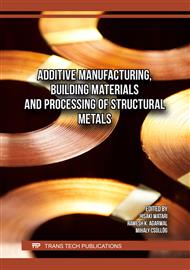[1]
Briard, T., Segonds, F., Zamariola, N.: G-DfAM: a methodological proposal of generative design for additive manufacturing in the automotive industry. International Journal on Interactive Design and Manufacturing (IJIDeM). 14, 875–886 (2020)
DOI: 10.1007/s12008-020-00669-6
Google Scholar
[2]
Lkadi, O., Nassraoui, M., Bouksour, O.: Aperçu sur la fabrication additive : technologies, matériaux, applications. IncertFia. 6, (2022)
DOI: 10.21494/ISTE.OP.2022.0881
Google Scholar
[3]
Gibson, I., Rosen, D., Stucker, B., Khorasani, M.: Additive Manufacturing Technologies. Springer International Publishing, Cham (2021)
Google Scholar
[4]
Wang, Z., Zhang, Y., Orquera, M., Millet, D., Bernard, A.: A New Hybrid Generative Design Method for Functional & Lightweight Structure Generation in Additive Manufacturing. Procedia CIRP. 119, 66–71 (2023)
DOI: 10.1016/j.procir.2023.02.127
Google Scholar
[5]
Lkadi, O., Abouhazim, S., Nassraoui, M., Bouksour, O.: A comprehensive design framework for additive manufacturing in the automotive industry: a case study. Archives of Materials Science and Engineering. 124, (2024)
DOI: 10.5604/01.3001.0054.4610
Google Scholar
[6]
Stavropoulos, P.: Additive Manufacturing: Design, Processes and Applications. Springer International Publishing, Cham (2023)
Google Scholar
[7]
Caetano, I., Santos, L., Leitão, A.: Computational design in architecture: Defining parametric, generative, and algorithmic design. Frontiers of Architectural Research. 9, 287–300 (2020)
DOI: 10.1016/j.foar.2019.12.008
Google Scholar
[8]
Shea, K., Aish, R., Gourtovaia, M.: Towards integrated performance-driven generative design tools. Automation in Construction. 14, 253–264 (2005). https://doi.org/10.1016/j.autcon. 2004.07.002
DOI: 10.1016/j.autcon.2004.07.002
Google Scholar
[9]
Lkadi, O., Nassraoui, M., Bouksour, O.: Design for Additive Manufacturing. In: Zarbane, K. and Beidouri, Z. (eds.) Proceedings of CASICAM 2022. p.207–217. Springer Nature Switzerland, Cham (2023)
DOI: 10.1007/978-3-031-32927-2_19
Google Scholar
[10]
Ait Ouchaoui, A., Nassraoui, M., Radi, B.: Numerical investigation of the effect of topology optimisation methods parameters in the topology quality, the strength, and the computational cost. Archives of Materials Science and Engineering. 123, 55–71 (2023)
DOI: 10.5604/01.3001.0054.2492
Google Scholar
[11]
Eljihad, A., Nassraoui, M., Bouksour, O.: Experimental investigation of mechanical stiffness in lattice structures fabricated with PLA using fused deposition modelling. Journal of Achievements in Materials and Manufacturing Engineering. 119, 60–71 (2023)
DOI: 10.5604/01.3001.0053.9491
Google Scholar
[12]
Oh, S., Jung, Y., Kim, S., Lee, I., Kang, N.: Deep Generative Design: Integration of Topology Optimization and Generative Models. Journal of Mechanical Design. 141, 111405 (2019)
DOI: 10.1115/1.4044229
Google Scholar
[13]
Wohlers, T.: Wohlers report 2019: 3D printing and additive manufacturing state of the industry. (No Title). (2019)
Google Scholar
[14]
Zhiping Wang. Constructive generative design methods for qualified additive manufacturing. Mechanical engineering [physics.class-ph]. École centrale de Nantes, 2021.
Google Scholar
[15]
Moreno Nieto, D., Moreno Sánchez, D.: Design for Additive Manufacturing: Tool Review and a Case Study. Applied Sciences. 11, 1571 (2021)
DOI: 10.3390/app11041571
Google Scholar
[16]
Vicente, D. A. R. d. S. B. (2021). Design and optimization of triple clamps for racing motorcycles. Instituto Superior Técnico.
Google Scholar
[17]
Pfingstl, S., Horoschenkoff, A., Höfer, P., Zimmermann, M. eds: Proceedings of the Munich Symposium on Lightweight Design 2020: Tagungsband zum Münchner Leichtbauseminar 2020. Springer Berlin Heidelberg, Berlin, Heidelberg (2021)
DOI: 10.1007/978-3-662-63143-0
Google Scholar
[18]
Akshay B*, Sony Alias, and Ramesh Kumar R. (2020). Design of a High-Performance Composite Triple Clamp of Motorbike. International Journal of Innovative Technology and Exploring Engineering, 9(3), 1253–1259
DOI: 10.35940/ijitee.c8708.019320
Google Scholar



